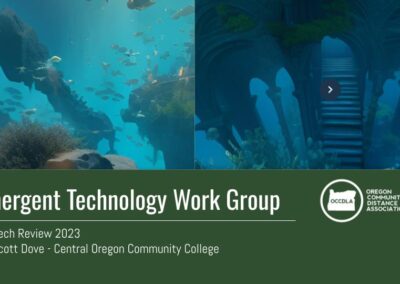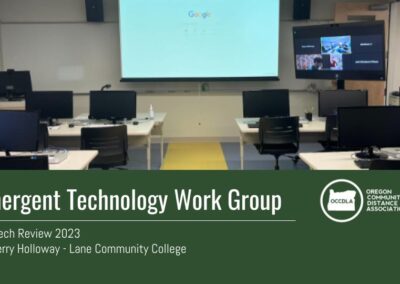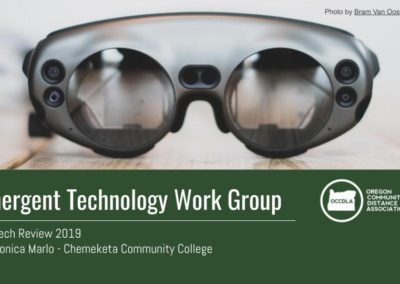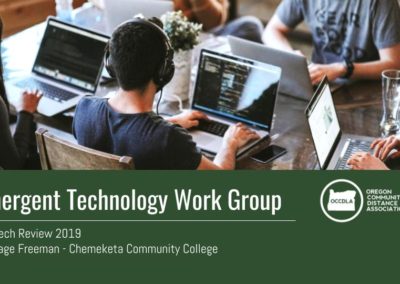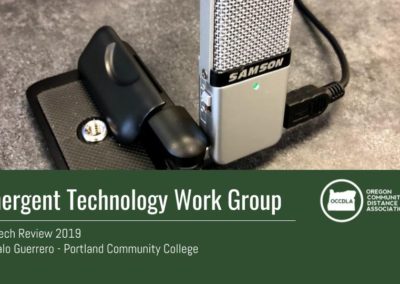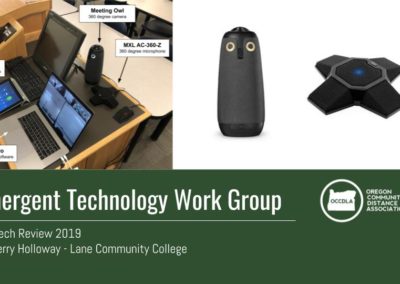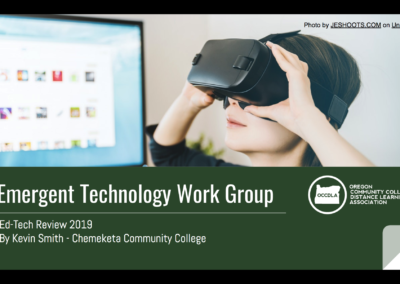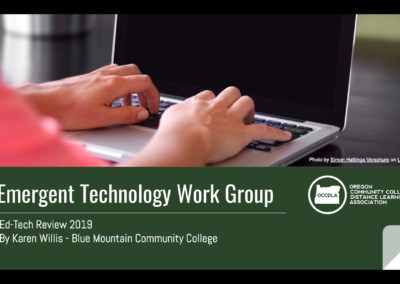EMERGENT TECHNOLOGY WORK GROUP – ED TECH REVIEWS
Immersive Learning Tool Kit
Ed Tech Review by:
Monica Marlo, Immedgineer – Distance Learning & Instructional Support, Portland Community College & member of the Emergent Technology Work Group.
Technology Reviewed:
- ViewMaster VR Headset
- Blitzwolf VR Headset & Remote
- Google Pixel and Daydream Headset
- HTC Vive
- Meta 2 Augmented Reality Headset
Exploration Intent
This request gave our multimedia course design facilitator and accessibility support teams access to equipment for initial review. This also enabled testing of content for integration and support requirements as instructors begin to utilize immersive media available in the market, as another form of instructional content delivery with itʻs own unique affordances. Note- we received four instructor requests, and one institutional need request this year.
Additionally, Portland Community College instructors will gain access to hands on exploration of augmented, virtual and mixed reality systems in upcoming sessions in our teaching and learning centers. If successful, this workshop will be documented for open statewide sharing through creative commons during the 17-19 biennium.
Through direct requests for support from our course design team, initially using content and experiences that can be found commercially off the shelf, our PCC distance education faculty will be given the opportunity to experience subject area specific content, to evaluate itʻs possible utility from their expertise, and offer our instructional design teams feedback and guidance for use.
An initial review has been conducted on each device and a sample of content available for each. Initial review plans have addressed the following for each device:
Individual vs classroom, lab or demo use
Rugged rating
- ViewMaster is by far the most rugged, solid, but least flexible to multiple user focal distance variance
- BlitzWolf VR
- Google Daydream
- HTC Vive- no available review until lab construction – 17-18
Hygiene
- The ViewMaster is solid plastic and can be fully cleaned
- BlitzWolf VR
- Google Daydream
- HTC Vive- no available review until lab construction- 17-18
Portability
- The ViewMaster is solid plastic and can be fully cleaned
- BlitzWolf VR
- Google Daydream
- HTC Vive- no available review until lab construction- 17-18
Quality of experience
- Comfort
- Audio
- Video
Universal access
- Financial , including total procurement cost, additional maintenance fees, hardware requirements, etc.
- Technical – Ease of use, system integration, long term support needs
- Accessible – universal utility to a continuum of abilities
Key Features
Smartphone based virtual reality devices
- Cost of entry can be as low as 5-10$ per device to add ar.vr.mr functions , though at this price point the experience can be rudimentary.
- Reasonable quality access can be found at $20-40, a modest equipment fee that can be amortized over multiple course use.
- Growing ubiquity of access to smartphones shrinks the hardware access gap, but access to data and network service plans may still create content use barriers
PC based tethered augmented reality device – Meta 2 Headset
Due to manufacturing delays, the Meta 2 headset was unable to be delivered within procurement deadlines. This initial request for equipment has been rescinded, to be addressed as the future budget climate is better known.
PC based tethered virtual reality device – HTC Vive
- Fully immersive, high render quality with little delay time between gesture and response. Near highest quality possible currently in a virtual reality headset
- A wide variety of commercial off the shelf options for content, with a growing library of titles and coordinated peripheral devices.
- Requires a workstation which includes a CPU, RAM and video card capable of sustaining 90 FPS for optimal performance. Note- at PCC, we are currently in the process of installing these machines in our MakerSpace fabrication laboratory. Due to the high cost and specialized abilities of a rendering machine, every effort is being made to maximise the efficacy of state budgets in exploration. This has had an impact on our research and development schedule, but one our values dictate as warranted.
Applications for Online Teaching & Learning
Below are some examples of how Immersive technologies can be used in teaching and learning:
Use the impact of place to engage learners, no matter where they are
Because immersive media gives users a sense of ʻbeing thereʻ, the engagement and impact of place can be simulated from anywhere, allowing poignant instructional content to be coupled with the opportunity to review performance data.
Guide learners in embodied reflection from an expertise point of view
Seeing the world through the eyes of an expert who is ʻfired upʻ about their subject helps foster enthusiasm for it, keeping learners engaged and following an instructionally designed trajectory. Engagement, guidance and an enthusiastic guide are all shown to have positive correlations with student success.
Universally design immersive experiences to enhance learning for a spectrum of abilities
The wide toolkit of media rich functions available in immersive environments allow for designers to partner with users of all abilities, and find novel and emergent ways to meet the communication needs of learners using immersive media to reach measurable objectives.
Access & Sustainability
One primary goal of this R&D request was to be able to access these tools for early exploration- both for our instructional design specialists and the wide team of faculty support available when contemplating solutions to meet learning objectives. We also want faculty to help us imagine how these tools can weave into their engaging online teaching practices, which requires their hands-on experience.
An attempt has been made to select gear tor review across a spectrum of price and levels of ease of use. As individual instructional design projects utilize tools from the immersive kit, the cost of procurement and possible additional partnerships wtih IT departments for support need to be addressed during the project design phase, so that any additional costs can be absorbed by respective budgets. Here at PCC, we will be addressing this on an as-needed basis, guided by our course development pipelineʻs hierarchy of initiatives.


